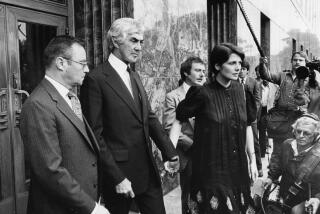The FBI wants to be less mysterious about a mystery
SEATTLE — After a search that has lasted more than 36 years, all of the evidence in the case of the legendary outlaw known as D.B. Cooper fits easily into an inconspicuous box, carried comfortably under the arm of FBI agent Larry Carr.
He is the newest in a line of about a dozen agents assigned to the case since 1971, when Cooper hijacked a passenger jet and bailed out over Clark County, Wash., with $200,000 in $20 bills. When the last agent moved on six months ago, Carr requested to take the case.
“How could you not?” he said. “It’s the ultimate mystery.”
One that was further deepened last month by a promising discovery: Children found an old parachute partially buried in their family’s field in southwest Washington, located almost exactly at the midpoint of a line drawn between the two spots where authorities think Cooper could have landed.
But like so many roads over the years, this one came to a dead end.
Very little has made it into the evidence box. Yellow with age and marked by brittle remnants of adhesive tape, it looks like something a college student might throw old books or sneakers into. Inside is a black polyester clip-on tie; a tie clasp with a button of fake pearl; an airline ticket bearing the name “Dan Cooper”; a green canvas parachute bag; a spare chute that Cooper cut up in order to use its cords; and some of the $20 bills found by a boy on the banks of the Columbia River in 1980.
Since then, nothing.
Still, the Cooper legend is as robust as ever. In part because so many years have passed, the FBI has adopted a more open approach to the case, inviting and even encouraging public participation.
A farmer’s back field, the old trunk of someone’s long-forgotten uncle, the sudden recollection of a strange conversation with a friend pulled from the attic of someone’s memory -- Carr figures that is the only place an answer will be found.
“He came from somewhere,” Carr said. “He came from someone.”
The FBI has entertained leads both incredible and plausible. A Florida woman told authorities that her late husband, Duane Weber, had confessed on his deathbed to being Cooper. A Minnesota man claimed that his brother, Kenneth Christiansen, was Cooper. Another tipster asserted that Cooper actually was a woman who had undergone a sex-change operation. Among the more far-fetched tips Carr received was a report that Cooper was the father of NASCAR drivers Kurt and Kyle Busch.
Before the recent parachute discovery, the FBI averaged about one tip a month submitted to its website. Since then Carr has gotten them at a rate of about one per day. The job of culling leads is Carr’s alone. His full-time responsibility at the bureau is to investigate bank robberies, so he depends on the momentum of public interest.
“This investigation has truly become a joint effort of the public, the media and law enforcement,” Laura Laughlin, special agent in charge of the Seattle division of the FBI, said in a written release after the parachute was ruled out. “We are confident the case can still be solved with this new emphasis.”
Until recently, the FBI had not been as forthcoming about the contents of the old cardboard box -- or about its theories on Cooper. The openness with which Carr now shares evidence represents a capitulation of sorts, a nothing-to-lose strategy, an admission that solving the mystery has become more relevant than prosecuting the criminal.
Cooper, who was once on the bureau’s list of 10 most wanted criminals, could call the FBI tomorrow, Carr said, and confess. “I could put him in handcuffs,” Carr said, but he was not sure the agency would have a “viable prosecution.”
Those who study popular culture say the appeal of the Cooper legend is rooted not just in the moral arithmetic but in the mystery surrounding the crime and the landscape over which it took place.
“Any good legend has to have a good location,” said T.V. Reed, director of the American studies department at Washington State University. The forests of the Pacific Northwest, with their towering canopies and floors of moss, fern and ivy, are the figurative keepers of secrets. While the forest was deadly enough to have killed Cooper, the overgrowth could have kept him hidden and allowed for his safe retreat.
If every antihero needs a foil, Cooper has Carr. The agent looks every part the hero, hair trimmed tight, square jaw, tall and broad-shouldered. He was a track star at Florida State University, an All-American in the pole vault. At 41, he looks fit enough to jump today. He has served in a K-9 unit, worked as a bodyguard for former Florida Gov. Jeb Bush and, for a short time, as an air marshal.
While recently taking inventory of the box, Carr recounted what he thought happened that night in 1971.
Cooper, he said, was a bit of a smart-aleck, shrewd enough to hatch such a bold plan but not competent enough to pull it off, someone with “just enough knowledge to be dangerous.”
He chose to make his jump at night and in bad weather. He did not request large bills, so he got 20s, making his loot that much harder to carry. He seemed inexperienced with parachutes, failing to recognize and use the best of the four he had to choose from: the modern sport chute that he cut up and used to secure the money to his body. Instead he chose an old Navy surplus model. The backup he strapped to his waist was an essentially useless training chute.
Carr thinks Cooper wanted to bail out closer to Seattle, perhaps over Pierce County, which he seemed familiar with from the air. About to jump, he likely stood at the end of the rear boarding stairs, the air rushing around him. The aerodynamics fooled him, affording him a spot of calm, like the eye of a hurricane.
When Cooper jumped, Carr speculated, the sudden blast of air ripped away the bag of money he had tied to his body. Cooper, disoriented and struggling for breath, tumbled through the darkness. He never pulled the rip cord, falling to his death. Scavengers -- cougars, bears, coyotes -- likely made quick work of his body.
“He probably planned to make this jump and start a new life,” Carr said. “He thought, ‘I know 727s. I know how to jump; I can do this.’ Standing there on the stairs, you don’t get the wind’s full blast. He probably couldn’t see anything. Up until the last moment, he still had no idea.”
More to Read
Sign up for Essential California
The most important California stories and recommendations in your inbox every morning.
You may occasionally receive promotional content from the Los Angeles Times.









